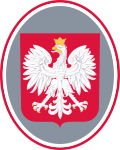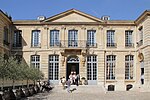Hôtel de Besenval
7th arrondissement of ParisHouses completed in 1862Hôtels particuliers in ParisMonuments historiques of Paris

The Hôtel de Besenval is a historic hôtel particulier in Paris with a cour d'honneur and a large English landscape garden, an architectural style commonly known as entre cour et jardin – meaning a residence between the entrance court in front of the building and the garden behind it. The building is listed as a historical monument by decree of 20 October 1928. It houses the Embassy of the Swiss Confederation and the residence of the Swiss Ambassador to France since 1938.
Excerpt from the Wikipedia article Hôtel de Besenval (License: CC BY-SA 3.0, Authors, Images).Hôtel de Besenval
Rue de Grenelle, Paris Quartier des Invalides (Paris)
Geographical coordinates (GPS) Address Phone number Nearby Places Show on map
Geographical coordinates (GPS)
| Latitude | Longitude |
|---|---|
| N 48.8583 ° | E 2.3159 ° |
Address
Ambassade de Suisse
Rue de Grenelle 142
75007 Paris, Quartier des Invalides (Paris)
Ile-de-France, France
Open on Google Maps










